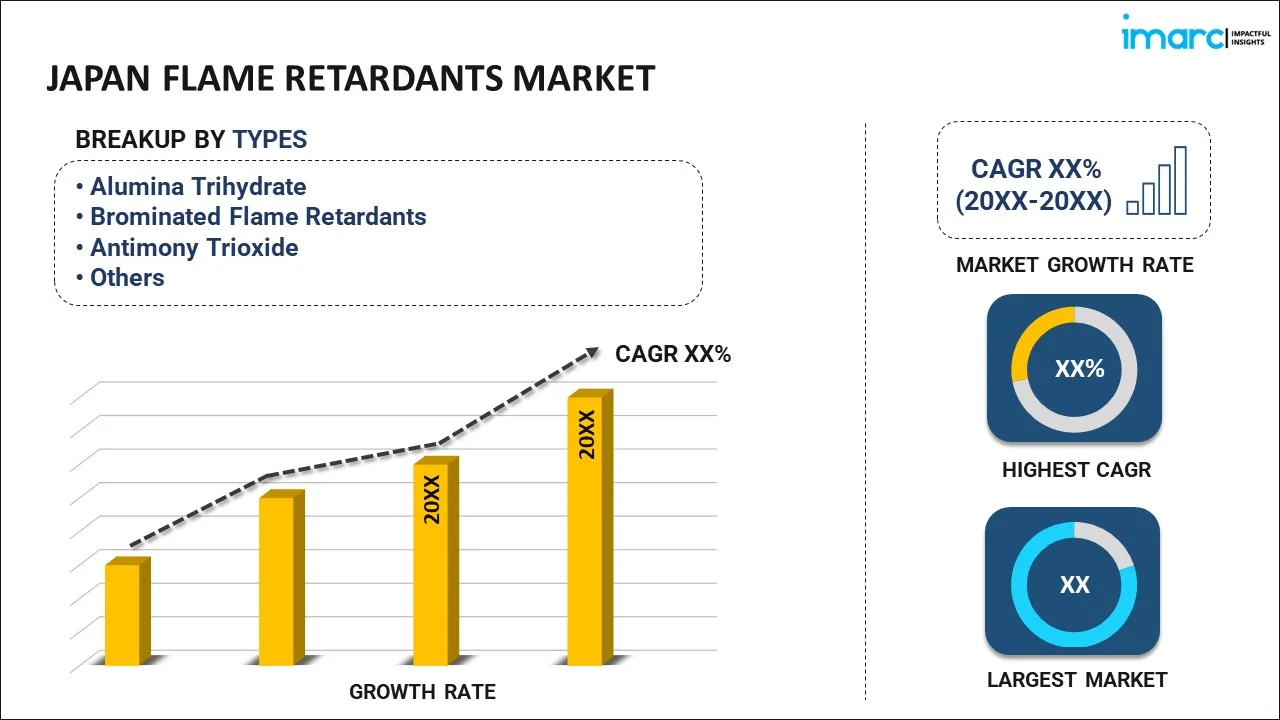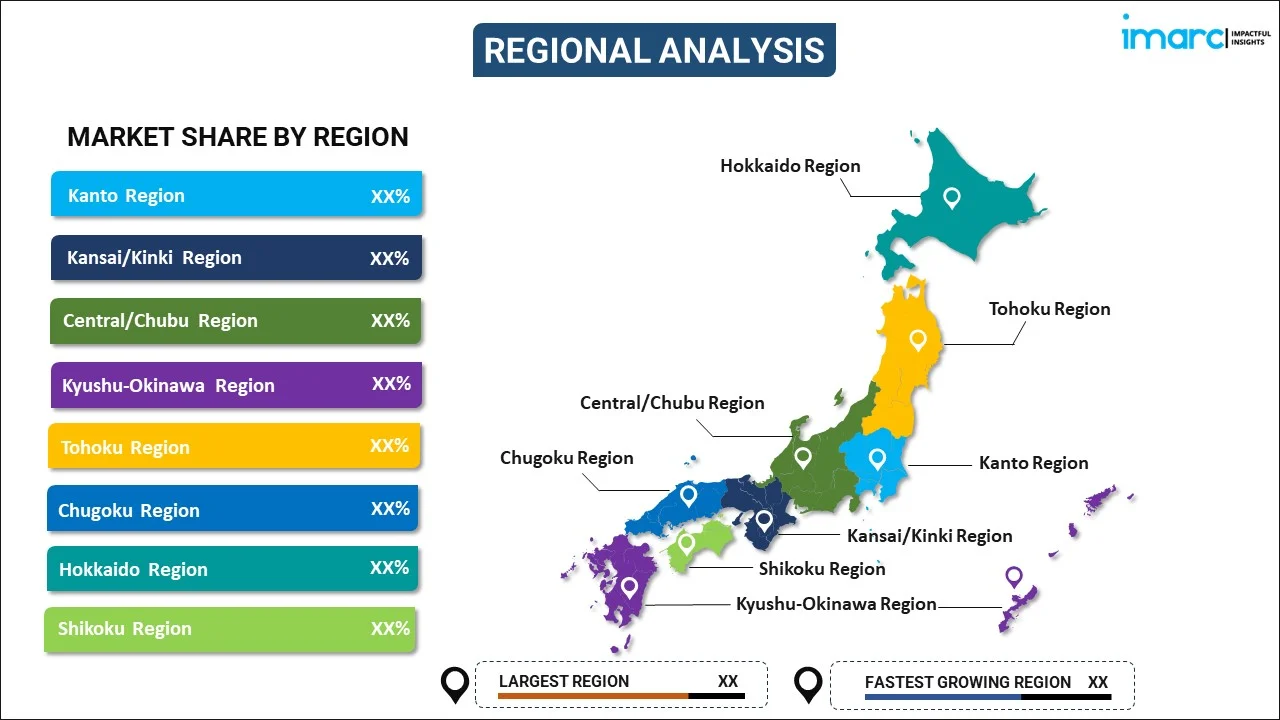
Japan Flame Retardants Market Report by Type (Alumina Trihydrate, Brominated Flame Retardants, Antimony Trioxide, Phosphorus Flame Retardants, and Others), Application (Unsaturated Polyester Resins, Epoxy Resins, PVC, Rubber, Polyolefins, and Others), End Use Industry (Construction, Wires and Cables, Automotive and Transportation, Electrical and Electronics, and Others), and Region 2025-2033
Market Overview:
Japan flame retardants market size reached USD 614.0 Million in 2024. Looking forward, IMARC Group expects the market to reach USD 865.0 Million by 2033, exhibiting a growth rate (CAGR) of 3.9% during 2025-2033. The market is experiencing growth primarily due to the increasing focus on fire safety regulations and standards in various industries, along with the emergence of bio-based flame retardants sourced from renewable materials.
|
Report Attribute
|
Key Statistics
|
|---|---|
|
Base Year
|
2024 |
|
Forecast Years
|
2025-2033
|
|
Historical Years
|
2019-2024
|
| Market Size in 2024 | USD 614.0 Million |
| Market Forecast in 2033 | USD 865.0 Million |
| Market Growth Rate (2025-2033) | 3.9% |
Flame retardants are chemical compounds or substances engineered to impede or decelerate the progression of fire. They possess the ability to withstand elevated temperatures without undergoing combustion themselves and contribute to augmenting the fire resistance of diverse products and materials by diminishing their susceptibility to ignition. Flame retardants play a pivotal role in prolonging the effective lifespan of materials and products by mitigating the harm caused by fire. They offer protection to electronic devices like computers and televisions by averting overheating and ignition. Additionally, flame retardants find extensive application in construction materials, including insulation, wiring, and paints, to enhance fire safety in buildings.
Japan Flame Retardants Market Trends:
In the context of the Japanese market, several factors are fueling market growth. One of the primary drivers is the widespread adoption of flame retardants across various industrial sectors to curb the rapid spread of fires and mitigate property damage. For instance, within the consumer electronics sector, flame retardants are extensively employed in insulating electric wires on circuit boards, electronic casings, wires, and cable systems to prevent fire incidents. Furthermore, the growing demand for these products in residential buildings and public spaces is contributing to market expansion. This increased demand stems from the escalating need for effective fire management solutions, driven by the greater use of flammable materials like plastics, foams, and composites. Additionally, the market is experiencing growth due to the introduction of safer alternatives, such as non-halogenated flame retardants based on phosphorous, bromine, and chlorine. These alternatives are both sustainable and safe for human exposure, which is significantly boosting market growth. Other contributing factors include the substantial growth in the chemical industry, extensive research and development (R&D) efforts, and the implementation of various government initiatives aimed at enhancing fire safety standards and regulations. These initiatives aim to reduce the incidence of explosion-related accidents in offices, industries, and public spaces, which is projected to propel the market growth in the coming years.
Japan Flame Retardants Market Segmentation:
IMARC Group provides an analysis of the key trends in each segment of the market, along with forecasts at the country level for 2025-2033. Our report has categorized the market based on type, application, and end use industry.
Type Insights:

- Alumina Trihydrate
- Brominated Flame Retardants
- Antimony Trioxide
- Phosphorus Flame Retardants
- Others
The report has provided a detailed breakup and analysis of the market based on the type. This includes alumina trihydrate, brominated flame retardants, antimony trioxide, phosphorus flame retardants, and others.
Application Insights:
- Unsaturated Polyester Resins
- Epoxy Resins
- PVC
- Rubber
- Polyolefins
- Others
A detailed breakup and analysis of the market based on the application have also been provided in the report. This includes unsaturated polyester resins, epoxy resins, PVC, rubber, polyolefins, and others.
End Use Industry Insights:
- Construction
- Wires and Cables
- Automotive and Transportation
- Electrical and Electronics
- Others
The report has provided a detailed breakup and analysis of the market based on the end use industry. This includes construction, wires and cables, automotive and transportation, electrical and electronics, and others.
Regional Insights:

- Kanto Region
- Kansai/Kinki Region
- Central/ Chubu Region
- Kyushu-Okinawa Region
- Tohoku Region
- Chugoku Region
- Hokkaido Region
- Shikoku Region
The report has also provided a comprehensive analysis of all the major regional markets, which include Kanto Region, Kansai/Kinki Region, Central/ Chubu Region, Kyushu-Okinawa Region, Tohoku Region, Chugoku Region, Hokkaido Region, and Shikoku Region.
Competitive Landscape:
The market research report has also provided a comprehensive analysis of the competitive landscape. Competitive analysis such as market structure, key player positioning, top winning strategies, competitive dashboard, and company evaluation quadrant has been covered in the report. Also, detailed profiles of all major companies have been provided.
Japan Flame Retardants Market Report Coverage:
| Report Features | Details |
|---|---|
| Base Year of the Analysis | 2024 |
| Historical Period | 2019-2024 |
| Forecast Period | 2025-2033 |
| Units | Million USD |
| Scope of the Report | Exploration of Historical and Forecast Trends, Industry Catalysts and Challenges, Segment-Wise Historical and Predictive Market Assessment:
|
| Types Covered | Alumina Trihydrate, Brominated Flame Retardants, Antimony Trioxide, Phosphorus Flame Retardants, Others |
| Applications Covered | Unsaturated Polyester Resins, Epoxy Resins, PVC, Rubber, Polyolefins, Others |
| End Use Industries Covered | Construction, Wires and Cables, Automotive and Transportation, Electrical and Electronics, Others |
| Regions Covered | Kanto Region, Kansai/Kinki Region, Central/ Chubu Region, Kyushu-Okinawa Region, Tohoku Region, Chugoku Region, Hokkaido Region, Shikoku Region |
| Customization Scope | 10% Free Customization |
| Post-Sale Analyst Support | 10-12 Weeks |
| Delivery Format | PDF and Excel through Email (We can also provide the editable version of the report in PPT/Word format on special request) |
Key Questions Answered in This Report:
- How has the Japan flame retardants Market performed so far and how will it perform in the coming years?
- What has been the impact of COVID-19 on the Japan flame retardants Market?
- What is the breakup of the Japan flame retardants Market on the basis of type?
- What is the breakup of the Japan flame retardants Market on the basis of application?
- What is the breakup of the Japan flame retardants Market on the basis of end use industry?
- What are the various stages in the value chain of the Japan flame retardants Market?
- What are the key driving factors and challenges in the Japan flame retardants?
- What is the structure of the Japan flame retardants Market and who are the key players?
- What is the degree of competition in the Japan flame retardants Market?
Key Benefits for Stakeholders:
- IMARC’s industry report offers a comprehensive quantitative analysis of various market segments, historical and current market trends, market forecasts, and dynamics of the Japan flame retardants Market from 2019-2033.
- The research report provides the latest information on the market drivers, challenges, and opportunities in the Japan flame retardants Market.
- Porter's five forces analysis assist stakeholders in assessing the impact of new entrants, competitive rivalry, supplier power, buyer power, and the threat of substitution. It helps stakeholders to analyze the level of competition within the Japan flame retardants Market industry and its attractiveness.
- Competitive landscape allows stakeholders to understand their competitive environment and provides an insight into the current positions of key players in the market.
Need more help?
- Speak to our experienced analysts for insights on the current market scenarios.
- Include additional segments and countries to customize the report as per your requirement.
- Gain an unparalleled competitive advantage in your domain by understanding how to utilize the report and positively impacting your operations and revenue.
- For further assistance, please connect with our analysts.
 Inquire Before Buying
Inquire Before Buying
 Speak to an Analyst
Speak to an Analyst
 Request Brochure
Request Brochure
 Request Customization
Request Customization




.webp)




.webp)












